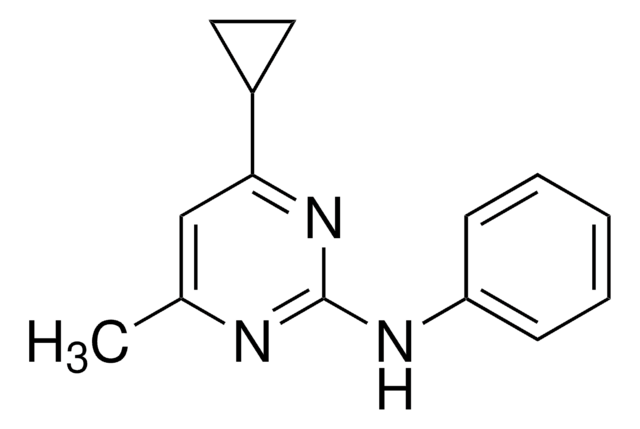모든 사진(1)
About This Item
실험식(Hill 표기법):
C17H12Cl2N2O
CAS Number:
Molecular Weight:
331.20
Beilstein:
5972869
EC Number:
MDL number:
UNSPSC 코드:
41116107
PubChem Substance ID:
NACRES:
NA.24
추천 제품
Grade
analytical standard
Quality Level
제품 라인
PESTANAL®
유통기한
limited shelf life, expiry date on the label
기술
HPLC: suitable
gas chromatography (GC): suitable
응용 분야
agriculture
cleaning products
cosmetics
environmental
food and beverages
personal care
형식
neat
SMILES string
OC(c1ccc(Cl)cc1)(c2cncnc2)c3ccccc3Cl
InChI
1S/C17H12Cl2N2O/c18-14-7-5-12(6-8-14)17(22,13-9-20-11-21-10-13)15-3-1-2-4-16(15)19/h1-11,22H
InChI key
NHOWDZOIZKMVAI-UHFFFAOYSA-N
유사한 제품을 찾으십니까? 방문 제품 비교 안내
일반 설명
Fenarimol belongs to the pyrimidine class of compounds.
애플리케이션
Fenarimol may be used as an analytical reference standard for the determination of fenarimol in:
- Honeys, honeybees and pollens by QuEChERS extraction followed by analysis using liquid chromatography-electrospray ionization-tandem mass spectrometry (LC-ESI-LC-MS/MS) combined with multiple reaction monitoring (MRM) detection.
- Grapes by ethyl acetate extraction, dispersive solid phase extraction (d-SPE) clean-up and LC-ESI-MS/MS with MRM detection.
- Fruit-based baby food samples by programmed temperature vaporizer injection-low pressure gas chromatography coupled with high resolution time-of-flight mass spectrometry (PTV-LP-GC-HR-TOF-MS).
- Foodstuffs by capillary GC-MS equipped with electron impact (EI) mode of ionization.
- Soya grain samples by LC-ESI-MS/MS.
Refer to the product′s Certificate of Analysis for more information on a suitable instrument technique. Contact Technical Service for further support.
법적 정보
PESTANAL is a registered trademark of Merck KGaA, Darmstadt, Germany
신호어
Warning
유해 및 위험 성명서
Hazard Classifications
Aquatic Chronic 2 - Lact. - Repr. 2
Storage Class Code
11 - Combustible Solids
WGK
WGK 2
Flash Point (°F)
212.0 °F - closed cup
Flash Point (°C)
100 °C - closed cup
개인 보호 장비
Eyeshields, Gloves, type P3 (EN 143) respirator cartridges
Choose from one of the most recent versions:
이미 열람한 고객
Jin-Cheol Kim et al.
Pest management science, 60(8), 803-808 (2004-08-17)
Methanol extracts of fresh materials of 183 plants were screened for in vivo antifungal activity against Magnaporthe grisea, Corticium sasaki, Botrytis cinerea, Phytophthora infestans, Puccinia recondita and Erysiphe graminis f sp hordei. Among them, 33 plant extracts showed disease-control efficacy
Michela Sugni et al.
Ecotoxicology (London, England), 19(3), 538-554 (2009-11-26)
Two echinoderm species, the sea urchin Paracentrotus lividus and the feather star Antedon mediterranea, were exposed for 28 days to several EDCs: three putative androgenic compounds, triphenyltin (TPT), fenarimol (FEN), methyltestosterone (MET), and two putative antiandrogenic compounds, p,p'-DDE (DDE) and
G Janer et al.
Aquatic toxicology (Amsterdam, Netherlands), 71(3), 273-282 (2005-01-27)
Testosterone conjugation activities, microsomal acyltransferases and cytosolic sulfotransferases, were investigated in three invertebrate species, the gastropod Marisa cornuarietis, the amphipod Hyalella azteca, and the echinoderm Paracentrotus lividus. The goals of the study were to characterize steroid conjugation pathways in different
Karen L Thorpe et al.
Aquatic toxicology (Amsterdam, Netherlands), 85(3), 176-183 (2007-10-19)
Mechanism specific biomarkers are used in ecotoxicology to identify classes of chemicals and to inform on their presence in the environment, but their use in signalling for adverse effects has been limited by a poor understanding of their associated links
Helle Raun Andersen et al.
Toxicology letters, 163(2), 142-152 (2005-12-06)
The fungicide fenarimol has the potential to induce endocrine disrupting effects via several mechanisms since it possesses both estrogenic and antiandrogenic activity and inhibits aromatase activity in cell culture studies. Hence, the integrated response of fenarimol in vivo is not
자사의 과학자팀은 생명 과학, 재료 과학, 화학 합성, 크로마토그래피, 분석 및 기타 많은 영역을 포함한 모든 과학 분야에 경험이 있습니다..
고객지원팀으로 연락바랍니다.












